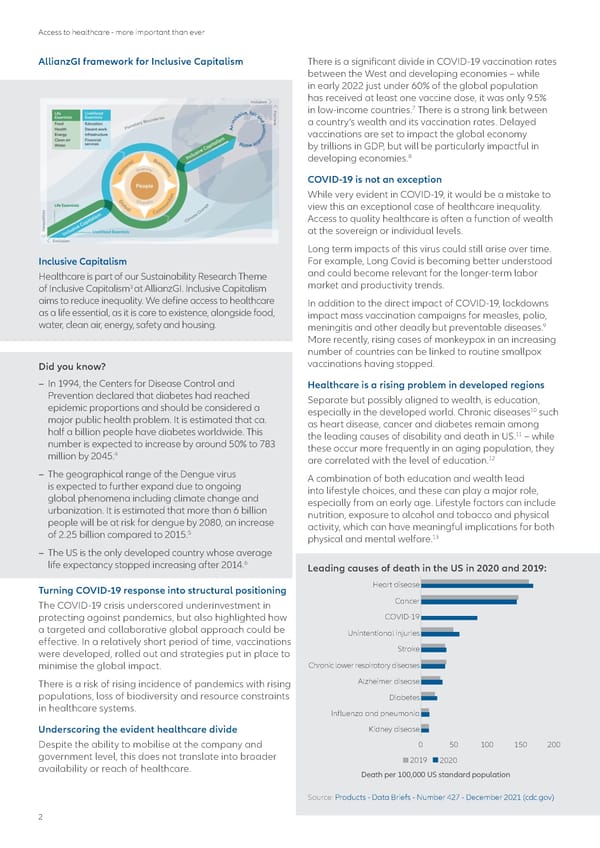Access to healthcare - more important than ever AllianzGI framework for Inclusive Capitalism There is a significant divide in COVID-19 vaccination rates between the West and developing economies – while in early 2022 just under 60% of the global population has received at least one vaccine dose, it was only 9.5% 7 in low-income countries. There is a strong link between a country’s wealth and its vaccination rates. Delayed vaccinations are set to impact the global economy by trillions in GDP, but will be particularly impactful in developing economies.8 COVID-19 is not an exception While very evident in COVID-19, it would be a mistake to view this an exceptional case of healthcare inequality. Access to quality healthcare is often a function of wealth at the sovereign or individual levels. Long term impacts of this virus could still arise over time. Inclusive Capitalism For example, Long Covid is becoming better understood Healthcare is part of our Sustainability Research Theme and could become relevant for the longer-term labor 3 market and productivity trends. of Inclusive Capitalism at AllianzGI. Inclusive Capitalism aims to reduce inequality. We define access to healthcare In addition to the direct impact of COVID-19, lockdowns as a life essential, as it is core to existence, alongside food, impact mass vaccination campaigns for measles, polio, water, clean air, energy, safety and housing. 9 meningitis and other deadly but preventable diseases. More recently, rising cases of monkeypox in an increasing number of countries can be linked to routine smallpox Did you know? vaccinations having stopped. – In 1994, the Centers for Disease Control and Healthcare is a rising problem in developed regions Prevention declared that diabetes had reached Separate but possibly aligned to wealth, is education, epidemic proportions and should be considered a 10 major public health problem. It is estimated that ca. especially in the developed world. Chronic diseases such half a billion people have diabetes worldwide. This as heart disease, cancer and diabetes remain among 11 number is expected to increase by around 50% to 783 the leading causes of disability and death in US. – while million by 2045.4 these occur more frequently in an aging population, they 12 are correlated with the level of education. – The geographical range of the Dengue virus A combination of both education and wealth lead is expected to further expand due to ongoing into lifestyle choices, and these can play a major role, global phenomena including climate change and especially from an early age. Lifestyle factors can include urbanization. It is estimated that more than 6 billion nutrition, exposure to alcohol and tobacco and physical people will be at risk for dengue by 2080, an increase activity, which can have meaningful implications for both of 2.25 billion compared to 2015.5 13 physical and mental welfare. – The US is the only developed country whose average life expectancy stopped increasing after 2014.6 Leading causes of death in the US in 2020 and 2019: Turning COVID-19 response into structural positioning Heart disease The COVID-19 crisis underscored underinvestment in Cancer protecting against pandemics, but also highlighted how COVID-19 a targeted and collaborative global approach could be Unintentional injuries effective. In a relatively short period of time, vaccinations Stroke were developed, rolled out and strategies put in place to minimise the global impact. Chronic lower resirator diseases There is a risk of rising incidence of pandemics with rising lheier disease populations, loss of biodiversity and resource constraints Diaetes in healthcare systems. Influena and neuonia Underscoring the evident healthcare divide idne disease Despite the ability to mobilise at the company and 0 50 100 150 200 government level, this does not translate into broader 2019 2020 availability or reach of healthcare. Death per 100,000 US standard population Source: Products - Data Briefs - Number 427 - December 2021 (cdc.gov) 2
 Access to healthcare – more important than ever Page 1 Page 3
Access to healthcare – more important than ever Page 1 Page 3